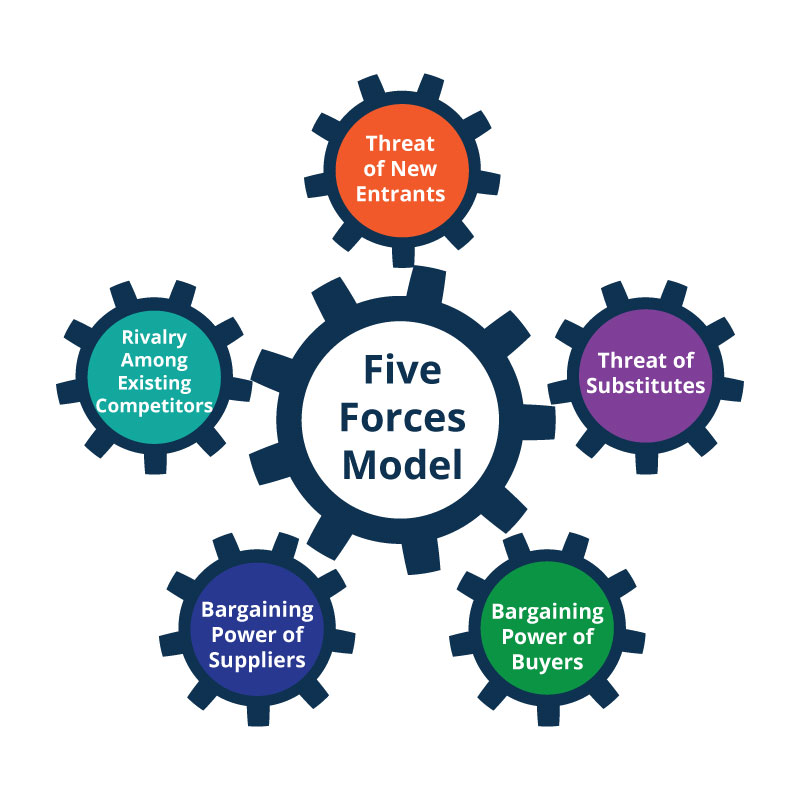Porter’s Five Forces Analysis: Assessing The Competitive Environment
It’s important to know who your competitors are and how their offering – their goods, services, and marketing strategies impact you. Competition has a direct impact on your performance, whether you are a Fortune 500 corporation or a small, local business.
Using Porter’s Five Forces model to evaluate your competition – and consider your role in your industry – is one way to do so. The five forces model was created in 1979 by Harvard Business School’s Michael E. Porter and looks at five basic factors that decide whether or not a business will be profitable in comparison to other companies in the industry. When paired with a SWOT analysis , Porter’s Five Forces will help you understand where your organisation or sector fits into the industry landscape.
A SWOT analysis is a microanalytical method that focuses on a single company’s data and analysis, while Porter’s Five Forces is a macro tool in market analytics that looks at the industry’s economy as a whole.
“Understanding the competitive forces, and their underlying causes, reveals the roots of an industry’s current profitability while providing a framework for anticipating and influencing competition (and profitability) over time,” Porter mentioned in a Harvard Business Review article . “A healthy industry structure should be as much a competitive concern to strategists as their company’s own position.”
What are Porter’s 5 Forces?
Understanding both the competitive forces at play and the overall market structure, according to Porter, is critical for successful strategic decision-making and creating a convincing potential competitive strategy.
The five forces that form industry competition, according to Porter’s model, are:
Market Competitiveness
The amount of competition your business faces is the first thing to consider. Market Competitiveness refers to how competitive and profitable a market is. The more competitive a market, the lower the profit opportunity becomes. Consider the number of direct competitors you have in your market, as well as the goods and services they provide in contrast to yours, on both a macro and micro scale.
Markets with few rivals are appealing, but they can be fleeting. High-competitive markets, on the other hand, with several competitors vying for the same job, will erode your power and force you to lower your prices and develop new goods.
Consider how easily rivals might enter your market and pose a threat to your business. For this, you might need to assess the following indicators:
- Market saturation
- Market diversity
- Industry concentration
- Industry growth
- Quality differences
- Brand loyalty
- Barriers to exit
- Switching costs
If competitors can reach your business with little money and effort, you’ll have to change your strategy to deal with them.
Bargaining Power of Buyers
Bargaining Power of Buyers refers to how much impact customers have on pricing structures.
When there are fewer buyers, they have more control, but when there are many sellers, consumers can easily turn. This enables consumers to put pressure on businesses to provide better product at lower prices. Buyer control, on the other hand, is diminished when supply is less than demand – when customers purchase small quantities of goods and the seller’s product is somewhat different from that of its rivals, purchasing power is low.
Have a look and review the following indicators:
- Number of customers
- Size of each customer
- Differences between competitors
- Buyer’s ability to substitute
- Price sensitivity
- Buyer’s information availability
- Switching costs
Bargaining Power of Suppliers
Almost every company has suppliers that sell components, material, labour, or finished goods. Suppliers wield some control over the business due to their prices and terms of supply. If there are fewer suppliers than customers, for example, the supplier will set a price rise because they have more leverage. When there are more suppliers than customers, however, the organization’s power grows, allowing it to negotiate terms and costs.
Know that your supplier, like you, can think strategically. If your supplier realises that only a few other companies can meet your needs, they may charge you more for their one-of-a-kind service. For instance, when Sony designs a new PlayStation model, it often collaborates with a single supplier to produce the most advanced processor chip possible for the game console. That means the processors’ supplier would be able to demand a reasonably high price, indicating that the supplier has clout. A company that requires product commodities such as gasoline, wheat, or aluminium, on the other hand, would have a large number of suppliers to choose from and can easily switch suppliers if the price or quality of a new partner is better. Power is typically low among commodity suppliers.
The metrics to consider are:
- Quantity of suppliers
- Capacity of suppliers
- Supplier specialness
- Contractual conditions
Threat of Substitution
Threats of substitution refers to opportunities where customers can easily substitute one product/service for another if they choose to do so. Mobile phone cameras, for example, have greatly improved and, for many users, have supplanted the need for a separate digital camera.
Differentiation is required to overcome the threat of alternative products, which can be accomplished by strong branding or product patents. Apple iPods, for example, fulfil the same needs as other branded MP3 players, but their good branding attracts consumers despite their higher price tag.
It is important not to mix up substitutes with competitors. Competitors have identical goods or services and compete directly with one another. Substitutes are entirely different goods or services that customers will be able to use in place of the existing product.
The following points should be considered:
- Number of product substitutes
- Buyer propensity to substitute
- Relative price performance of substitute
- Perceived level of differentiation
- Switching costs
Threat of New Entrants
When a market is especially lucrative and demand exceeds supply, new entrants are more likely to enter. This raises the level of competition and lowers the level of profitability for existing businesses.
Depending on the barriers to entry, or factors that prohibit new companies from effectively competing in the market, different industries can be easier or harder to join. Price, brand loyalty, and market growth are all common barriers to entry. For example, new entrants to the airline industry are rarely a threat because obtaining the necessary equipment, airport landing rights, and expertise to start a new airline is extremely costly.
Patents, brand, government policy, and legislation are all options for dealing with this challenge.
In your analysis, you might consider the following factors:
- Barriers to entry
- Economies of scale
- Brand loyalty
- Cumulative experience
- Government policies
Strategies for success
Once you finish your analysis and research, it is necessary to put an execution plan in place in order to improve your competitive edge. To that end, Porter identified three generic strategies that can be implemented in any industry (and by companies of any size.)
- COST LEADERSHIP – Your aim is to raise profits by lowering costs while charging industry-standard rates, or to increase market share by reducing the purchase price while maintaining profits. Cost leadership does not imply that you produce low-quality products at low prices. Otherwise, your company is doomed to fail in the end. To implement this strategy, a company must manufacture products of appropriate quality that are tailored to a particular group of consumers at a significantly lower or competitive price than other companies selling the same product.
- DIFFERENTIATION – To put this strategy into action, the company’s goods must be substantially better than the competition’s, boosting its competitiveness and public value. It necessitates extensive research and growth, as well as efficient sales and marketing.
- FOCUS – In order to execute effectively, the organisation must first recognise niche markets in which to sell their products. It necessitates a comprehensive knowledge of the industry, its sellers, customers, and competitors.
Additional materials that we recommend:
- Porter’s Five Forces ‘Understand competitive forces and stay ahead of the competition’
- Porter, M.E., The five competitive forces that shape strategy, Harvard Business Review(Jan 2008).
- “The charts that changed the world,” Harvard Business Review (2011)
In you need any assistance, Planium Pro offers a wide range of useful Marketing Tools for your business plan to help you better understand your client’s competitive landscape and provide opportunities to help grow their marketing strategy. Sign up for a 14-day trial today.










